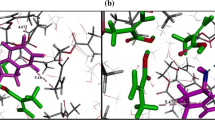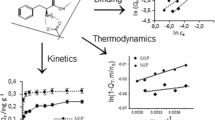Abstract
The molecular imprinting of polymers is a promising concept for designing highly selective receptor systems which is now fairly well understood from a structural point of view. However, only limited information is available on the thermodynamics of enantioselective recognition in imprints. In order to study this problem, the interactions of a pair of enantiomers (phenyl-α-L- and phenyl-α-D-mannopyranoside) with a well-characterized imprinted polymer (D-enantiomer acted as template) have been investigated by means of isothermal batch and titration calorimetry. Batch calorimetric measurements with unstirred samples are affected by strong solvent–polymer interactions, such as swelling, causing large changes of the blank effects over long periods of time. Isothermal titration calorimetric measurements proved to be more efficient for studying imprinted polymers. The enthalpies of rebinding for both enantiomers strongly decrease with increasing degree of occupation of the available cavities. Only at low degrees of occupation (< 50%) was a significantly higher endothermic heat effect for the (D)-enantiomer (template) detected which indicates an enantioselective rebinding. The overall heats of rebinding were found to be endothermic and are composed of several different contributions that are discussed. In summary, the reported calorimetric results are generally in accordance with the proposed mechanism of chiral recognition in this type of molecular imprinted polymers.
Similar content being viewed by others
References
F. Vögtle: Supramolecular Chemistry, John Wiley (1991).
D.J. Cram: Angew. Chem. 100, 1041 (1988); Angew. Chem. Int. Ed. Engl. 27, 1009 (1988).
J.M. Lehn: Angew. Chem. 100, 91 (1988); Angew. Chem. Int. Ed. Engl. 27, 89 (1988).
G. Wenz: Angew. Chem. 106, 851 (1994); Angew. Chem. Int. Ed. Engl. 33, 803 (1994).
Reviews see, e.g., (a) G. Wulff: Angew. Chem. 107, 1958 (1995); Angew. Chem. Int. Ed. Engl. 34, 1812 (1995). (b) K.J. Shea: Trends Polym. Sci. 2, 166 (1994). (c) K. Haupt and K. Mosbach: Trends Biotechnol. 16, 468 (1998). (d) M.J. Whitcombe and E.N. Vulfson: Adv. Mat. 7, 467 (2001).
(a) G. Wulff and M. Minarik: J. High Resolut. Chromatogr., Chromatogr. Commun. 9, 607 (1986). (b) B. Sellergren, M. Lepistö, and K. Mosbach: J. Am. Chem. Soc. 110, 5853 (1988). (c) B. Sellergren and K.J. Shea: J. Chromatogr. 654, 17 (1993).
(a) B. Sellergren: J. Chromatogr. 906, 227 (2001). (b) L.I. Andersson: J. Chromatogr. B 745, 3 (2000).
(a) J.V. Beach and K.J. Shea: J. Am. Chem. Soc. 116, 379 (1994). (b) G. Wulff, T. Groß, and R. Schönfeld: Angew. Chem. 109, 2049 (1997); Angew. Chem. Int. Ed. Engl. 36, 1961 (1997).
G. Chen, L. Guan, C.-T. Chen, L. Fu, V. Sundaresan, and F.H. Arnold: Nature Biotechnology 15, 354 (1997).
G. Vlatakis, L.I. Andersson, R. Müller, and K. Mosbach: Nature (London) 361, 645 (1993).
(a) S. Saraswathi and M.H. Keyes: Enzyme. Microb. Technol. 6, 98 (1985). (b) L. Braco, K. Dabulis, and A.M. Klibanov: Proc. Natl. Acad. Sci., USA 87, 274 (1990).
(a) P. Sajonaz, M. Kele, G. Zhong, B. Sellergren, and G. Guiochon: J. Chromatogr. A 810, 1 (1998). (b) K. Miyabe and G. Guiochon: Biotechn. Progr. 16, 617 (2000). (c) C. Baggiani, G. Giraudi, F. Trotta, C. Giovannoli, and A. Vanni: Talanta 51, 71 (2000). (d) R.J. Umpleby II, S.C. Baxter, M. Bode, J.K. Berch, R.N. Shah, and K.D. Shimizu: Anal. Chim. Acta 435, 35 (2001). (e) W.-Y. Chen, C.-S. Chen, and F.-Y. Lin: J. Chromatogr. A 923, 1 (2001).
G. Wulff, J. Vietmeier, and H.-G. Poll: Makromol. Chem. 188, 731 (1987).
G. Wulff and G. Kirstein: Angew. Chem. 102, 706 (1990); Angew. Chem. Int. Ed. Engl. 29, 684 (1990). See also G. Kirstein: PhD Thesis, Heinrich-Heine-University Düsseldorf (1989).
H.-G. Poll: PhD Thesis, Heinrich-Heine-University Düsseldorf (1986).
R. Kirchner, J. Seidel, and G. Wolf: Thermochim. Acta 310, 19 (1998).
G. Wulff, R. Grobe-Einsler, W. Vesper, and A. Sarhan: Makromol. Chem. 178, 2817 (1977).
J.M. Connor and V.C. Bulgrin: J. Inorg. Nucl. Chem. 29, 1953 (1967).
Author information
Authors and Affiliations
Rights and permissions
About this article
Cite this article
Kirchner, R., Seidel, J., Wolf, G. et al. Calorimetric Investigation of Chiral Recognition Processes in a Molecularly Imprinted Polymer. Journal of Inclusion Phenomena 43, 279–283 (2002). https://doi.org/10.1023/A:1021243826862
Issue Date:
DOI: https://doi.org/10.1023/A:1021243826862




